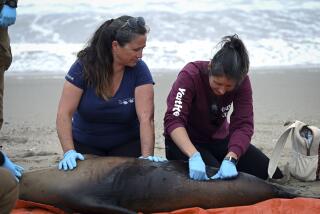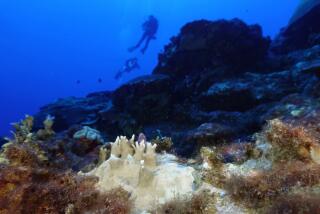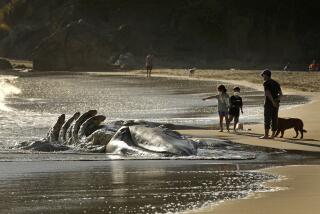Marine Life Withers Under a Wave of Human-Caused Diseases
- Share via
It is hardly news that the oceans are in trouble. After all, it’s been more than three decades since the late Jacques-Yves Cousteau first introduced millions of television viewers to the glories of the undersea world and to the havoc that humans had already begun wreaking on marine life.
But even the old Frenchman-of-the-sea himself would be shocked by the conditions we’ve created in the oceans today, especially in coastal waters, the shores and bays where most people come to know and enjoy the sea. These waters are sick and growing sicker by the day. In recent years, a startling number of marine epidemics has been burning through populations of sea creatures to the point that extinction threatens some species.
Some of these plagues are old and well-known, reawakened with unexpected virulence. Others are caused by pathogens new to science. After years of speculation, two recent studies go much further than ever in implicating humans in this “marine metademic.” A study published recently in the journal Science suggests that ocean waters heated by global warming are allowing bacteria, fungi and viruses to reproduce faster and range farther, unchecked by the older, cooler cycles of climate.
Global warming plays an important role, but it alone doesn’t fully explain the devastating marine outbreaks. For years humans have also been flooding coastal waters with nutrients. Agricultural runoff from fields and giant feedlots flows into rivers and eventually finds its way to the sea, providing a veritable smorgasbord for disease-causing organisms.
This overabundance of nutrients--and the introduction of human sewage in some places--plays a critical role in the marine metademic. Take the case of elkhorn coral. This magnificent branching coral was once the most abundant reef-building species in the Caribbean. Now it is virtually wiped out.
The result is an ecological catastrophe: a shift from spectacularly biodiverse coral reefs, sometimes called the “rain forests of the sea,” to algae-covered rubble. The puzzle of this massive die-off was partly solved when a team of scientists announced recently that it had isolated the agent responsible for one of the diseases: the bacterium Serratia marcescens. The name may be unfamiliar, yet it is not an exotic deep-sea pathogen but one commonly found in human feces and sewage.
The list of human insults to the ocean goes beyond global warming and introduction of nutrients. We overfish nearly everywhere, eliminating herbivorous fish that once kept harmful algae in check. We drain wetlands and dredge channels and harbors, turning clear, sandy-bottom areas into muck-covered wastelands, a perfect medium for microbes. We’re turning our coast into a giant petri dish, a pathogen-friendly environment in which microbes flourish at the expense of sea life.
It is possible to return our coastal waters to health, but it will require action on a number of fronts. We must fight global warming by implementing the Kyoto Protocol and by stopping the absurd dithering over whether the problem even exists, as the Bush administration continues to do. We must include agricultural runoff under the Clean Water Act; increase the number of marine protected sanctuaries where aquatic life can regroup from human assaults; and fully fund the National Oceanic and Atmospheric Administration.
A century before Cousteau opened our eyes to the wondrous world beneath the waves and the destruction we’re causing there, the father of modern pathology, Rudolph Virchow, wrote that “epidemics are like signposts from which the statesman of stature can read that a disturbance has occurred in the development of his nation that not even careless politics can overlook.” It is past time to heed the many watery signposts alerting us that all is not well in the nation of the sea.






